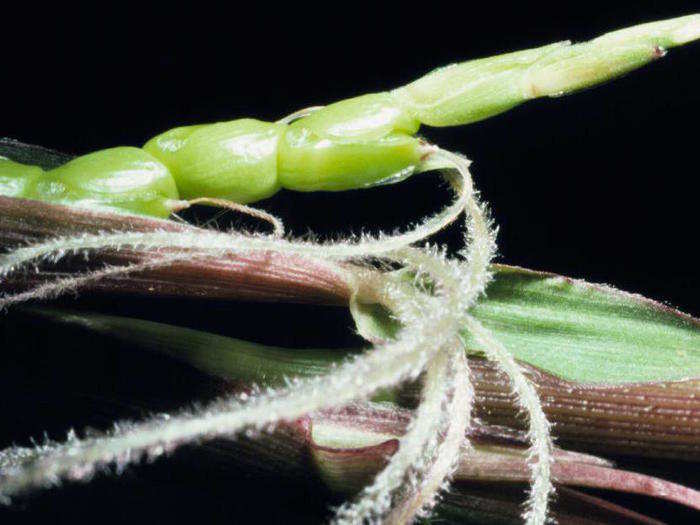
Roughly 10,000 years ago, farmers in what is now Mexico noticed that not all of their maize plants were the same. Some were bigger; some tasted better. So they started saving kernels from the plants they favored and planted them for the next season. Thanks to what we now call selective breeding, cobs of maize grew bigger and sweeter over time.
Natural corn, shown above, was first domesticated in 7,000 BC and was dry like a raw potato, according to an infographic by chemistry teacher James Kennedy.

Today, corn is 1,000 times larger than it was 9,000 years ago and much easier to peel and grow. Also, a whopping 6.6% of the vegetable is made up of sugar, compared with just 1.9% in natural corn, according to Kennedy. About half of these changes occurred since the 15th century, when European settlers began cultivating the crop.

Eggplants also weren't always the large, deep purple veggie we know them to be today. Once upon a time, they were white. Some were bright blue. Still others (like those in the photo) were yellow and round. Some of the earliest eggplants were cultivated in China. And early versions of the veggie once had spines where the plant's stem now connects to its flowers.

Thanks to selective breeding, eggplants no longer have spines and instead are a long, oblong shape with a characteristically deep purple hue.

Before modern-day bananas existed, people may have bred Musa acuminata, a plant with puny pods that could be bred to produce a seedless fruit. These spindly plants date back to at least 6,500 years ago in what is now Papua New Guinea, according to Smithsonian. Archaeological records suggest that acuminata was then bred with another related plant, the Musa balbisiana, which resulted in tasty plantains. Present-day bananas are thought to be the progeny of these plantains.

Mmm. By breeding combinations of the two wild varieties together, farmers eventually created our modern-day favorite: The sweet complement to any peanut butter sandwich. The bananas we take for granted today also owe their handy shape and convenient outer peel to hybridization. Plus, compared with its ancestors, the fruit of today has smaller seeds, a superior taste, and also comes packed with far more nutrients.

This 17th-century painting by Giovanni Stanchi depicts a watermelon that looks strikingly different from modern melons, as Vox points out. Looking closer at the fruit in the painting, which was made sometime between 1645 and 1672, you can make out a few swirly shapes embedded in what looks like some very dry, white fruit. Look at all those gnarly black seeds!

Over time, our ancestors bred watermelons to have the red, pulpy interior we know today. Some people think the watermelon in Stanchi's painting may just be unripe or unwatered, but the black seeds in the painting suggest that it was, in fact, ripe.

The earliest known carrots were thought to have been grown sometime during the 10th century in what is now Eastern Turkey. These were thought to originally be purple or white with a thin, forked root. Throughout their history, breeders favored different colors of carrots — sometimes purple, sometimes white, and today, orange. Earlier this month, scientists were able to pin down the precise carrot gene which gives rise to carotenoids, a critical source of Vitamin A and the source of their now characteristic orange pigment.

Farmers domesticated these thin, white roots, which had a strong flavor and biennial flower, into these large, tasty orange veggies that are an annual winter crop. Earlier this month, scientists were able to pin down the precise carrot gene which gives rise to carotenoids, a critical source of Vitamin A and the source of their now characteristic orange pigment.

Peaches were once small, cherry-like fruits with little flesh. They were first domesticated around 4,000 BC by the ancient Chinese and tasted earthy and slightly salty, "like a lentil," according to Kennedy.

But after thousands of years of farmers selectively breeding them, peaches are now a hefty 64 times larger. They're also roughly 27% juicier and 4% sweeter. Yum.
So next time someone tells you we shouldn't be eating food that's been genetically modified, you can tell them we already are.
 US buys 81 Soviet-era combat aircraft from Russia's ally costing on average less than $20,000 each, report says
US buys 81 Soviet-era combat aircraft from Russia's ally costing on average less than $20,000 each, report says 2 states where home prices are falling because there are too many houses and not enough buyers
2 states where home prices are falling because there are too many houses and not enough buyers A couple accidentally shipped their cat in an Amazon return package. It arrived safely 6 days later, hundreds of miles away.
A couple accidentally shipped their cat in an Amazon return package. It arrived safely 6 days later, hundreds of miles away. ICICI Bank shares climb nearly 5% after Q4 earnings; mcap soars by ₹36,555.4 crore
ICICI Bank shares climb nearly 5% after Q4 earnings; mcap soars by ₹36,555.4 crore
 Markets rebound sharply on buying in bank stocks firm global trends
Markets rebound sharply on buying in bank stocks firm global trends
 Bengaluru's rental income highest in Q1-2024, Mumbai next: Anarock report
Bengaluru's rental income highest in Q1-2024, Mumbai next: Anarock report

Copyright © 2024. Times Internet Limited. All rights reserved.For reprint rights. Times Syndication Service.